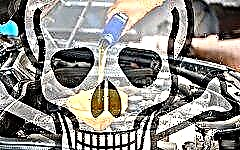

The content of the article:
- Work to wear
- Crossing puddles
- Irregular oil change
- Use of additives
- Improper operation of the radiator
Each vehicle requires attention and care in order to please its owner with the absence of malfunctions for as long as possible. To a greater extent, the condition of the car is affected by its careful operation, which directly affects the speed and level of wear of the chassis and engine.
Sometimes the car owner, without realizing it, makes banal but critical mistakes that affect the correct operation of the engine and bring its overhaul closer. Therefore, the driver must determine for himself the driving style and the manner of dealing with an iron friend - whether he will exploit it to the limit or heed the manufacturer's recommendations for a careful attitude.
1. Work for wear

On average, every modern car is designed to run within 400 thousand kilometers. If the owner is not Fedor Konyukhov, then this stock will be enough for an ordinary driver for many years of travel. This assumes that the car will move at a speed of 60-80 km / h, periodically reaching 130-150 km / h.
Manufacturers also assume that drivers will stick to high revs at 4 and 5 speeds, and pick up this speed at low revs. All possible traffic situations were included in the calculations for the operation of a car engine, including traffic jams, the specifics of roads, long and short stops, jerky movements and other driving features.
If you carefully study the operating manual and take into account all the wishes of the manufacturer, you can exist in harmony with your car for a long time.
What happens if you drive at low revs, squeeze out the top speed and start from a place with tire smoke?
Driving at low revs, which old-school drivers often sin, is often justified by good intentions - lower fuel consumption, reduced noise in the cabin and the illusion of increasing engine resource. But only if you need to increase the speed by sharply pressing the gas pedal while maintaining the current gear, or go to a step lower, you can provoke unpleasant processes.
In the first case the engine, which already works under heavy load, is forced to literally drown in a significant wave of incoming fuel.
In the second case will abruptly switch from an extreme load mode to an optimal one. At the same time, those drivers whose cars are equipped with an on-board computer may see an increase in fuel consumption, even despite the seemingly savings in low gear.
2. Crossing puddles

The childish love of forcing puddles remains with some adults, including motorists. But they forget that no one is insured against a fatal water hammer, even if the obstacle seems outwardly insignificant.
The danger of a swift passage of a full-flowing puddle lies in the fact that the wall of water formed in front of the hood through the air filter enters the engine, and the piston is not able to compress it.
The consequence will be a sharp stop of the engine while receiving a large dose of kinetic energy, breaking the metal innards. And the higher the speed at the moment of impact, the more harm the water will cause to the heart of the car. Connecting rod, cylinder head, drive belt, sensors, wiring may require repair and replacement due to collision with such an obstacle.
Therefore, a high-speed crossing of an ordinary, seemingly harmless puddle with a spectacular spray fountain is the surest way to quickly kill the engine. Especially if the car's air intake system is located low and is able to draw water even in light rain.
You should also not stop the car if it has already driven into a puddle. Restarting the engine will almost certainly result in a water hammer.
3. Irregular oil change

The operating manual for any machine contains instructions on the timing of the oil change, which is usually recommended to be done at least once every 10-15 thousand km. Here are just some drivers, either out of carelessness, or in order to save money, or as part of the fight against intrusive marketers, stretch this period two or even three times.
An extra couple of thousand kilometers on old oil will not do much harm, but if the excess is 5 thousand or more, this will seriously affect the engine.
Over time, the oil and its additives will lose their useful qualities, oxidize, and lose their lubricating effect, forcing the engine to run dry. This in turn will lead to the following:
- excessive friction of parts, which will increase the load on all units and assemblies;
- overheating of the engine due to the loss of the oil's ability to remove heat;
- loss of corrosion protection.
4. Use of additives

Recently, engine additives have become widespread. They are specially developed substances with lubricating qualities, added to engine oil for a specific purpose - fuel-saving, cleaning, anti-friction, oil. Some of them enhance the properties of engine oil, some are poured into an empty tank and save a quarter of fuel consumption, and some remove the resulting carbon deposits in the engine compartment.
Despite all their advantages, you should not abuse the additives, much less often change them or use all of them at the same time.
The presence of mineral powder in the additive accelerates the clogging of the oil channels, the octane corrector contributes to the clogging of the fuel supply system, and manganese very quickly destroys the catalytic converter.
5. Improper operation of the radiator

The cleanliness and well-being of the radiator directly affects the condition of the engine - the radiator takes on a powerful daily mud blow: insects clogging up in the grille, fluff from trees, sand, chemicals, other road debris are gradually compressed into a dense layer and causes the engine to overheat.
Every car owner is able to independently check the level of contamination of the radiator. First, you should completely drain the antifreeze and assess its purity. If the liquid is of an adequate color, does not have rust or other sediment, then flushing the radiator is not required. If the antifreeze is not of the appropriate type, then the cooling system is filled with distilled water, the engine is started and left running for 15-20 minutes.
When draining the water, it is again necessary to assess the level of its contamination, and then repeat this procedure as many times until the water becomes clear.
You can speed up the process and make it more effective with the help of simple improvised means - anti-scale or caustic soda. It will take a very small amount of cleaning powder to achieve the result, but overuse of it can damage the cooling system even more.
At the end of the radiator flushing, especially if a cleaning agent was used, the water must be completely drained, and then washed several more times with absolutely clean liquid without any additives. If this is not done, then even the smallest residues of household chemicals can cause extensive corrosion in the radiator.
To prevent the formation of various kinds of precipitation, rust and scale, the above additives are used, which are added to antifreeze.They contain ethylene glycol, which has not only anti-corrosion properties, but also lubricating properties that prevent the formation of deposits.
Also, to protect the engine from overheating, the grille should be regularly cleaned with a wire brush, especially after trips out of town. At any car wash, you should additionally blow out the radiator with compressed air.
Systematic cleaning of the radiator will help maintain the most important units in normal working order, and, therefore, protect the engine from boiling, and its owner from the cost of overhaul.
Conclusion
There are many ways to destroy your own car quickly and efficiently, ranging from neglect to drunk driving.
When the owner has a really good car, worth a lot of money, purchased for a long time, but simply does not know how to operate it correctly, it is unpleasant and even insulting. Therefore, the mere observance of the listed most elementary rules will extend the life of the engine, not just for years, but for whole decades. And the motorist - to keep his financial resources intact, saving on major repairs.











